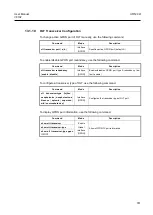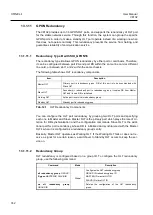
UMN:CLI
User Manual
V8102
730
no ip vrf onfail-use-vrf0
Disables the lookup into a global routing table.
12.7.4
VRF in the Dynamic Routing Daemons
12.7.4.1
OSPF
The OSPF process that created by this command updates the virtual routing table config-
ured in the command line. The OSPF VRF feature is used to advertise the routing infor-
mation between the CE and the PE.
The OSPF process sends the routing information that was advertised into the NSM. This
is sent to the NSM server by the NSM-Protocol messaging protocol. Because the NSM
message that is sent to the NSM server includes VRF-ID value, the routing information
that is sent from the dynamic routing protocol to the NSM daemon makes an appropriate
VRF routing table updated.
To specify the existing VRF instance in running OSPF, use the following command.
Command
Mode
Description
router ospf WORD NAME
Global
Specifies the VRF instance in running OSPF/OSPFv3
process. A specified OSPF/OSPFv3 process imple-
ments routing with the interfaces connected to this
VRF.
WORD: 1-65535, OSPF/OSPFv3 process ID
NAME: VRF name to associate with this instance
router ipv6 ospf WORD NAME
no router ospf WORD NAME
Removes the configured VRF from OSPF process
no router ipv6 ospf WORD
NAME
You can run a specific OSPF/OSPFv3 process with same network and neighbor per VRF
instance, which was created with VPN Routing/Forwarding instance name using
ip vrf
WORD
command.
12.7.4.2
BGP
The BGP supports the feature to advertise the routing information between CE and PE,
and between PE and PE. Use the following command in order to enable address family
routing process, which open you in
Address-Family Configuration
mode.
Command
Mode
Description
address-family ipv4 vrf NAME
Router
Opens the
Address-Family-VRF Configuration
mode to enable the exchanging of IPv4/IPv6 VRF
routing information between PE and CE.
NAME: VRF name
address-family ipv6 vrf NAME
address-family vpnv4
[
unicast
]
Opens the
Address-Family-VPN Configuration
















































